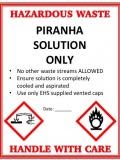Piranha Solutions
Overview
Piranha solutions are used to remove organic residues from substrates, particularly in microfabrication labs. The traditional piranha solution is a 3:1 mixture of sulfuric acid and 30% hydrogen peroxide. The solution may be mixed before application or directly applied to the material, applying the sulfuric acid, followed by the peroxide.
Piranha solutions are extremely energetic and may result in explosion or injury resulting from chemical and thermal burns if not handled with extreme caution. Piranha solutions may irritate the respiratory tract if vapor is inadvertently inhaled.
Emergency Procedures
Skin Contact: Flush the skin with copious amounts of water for at least 15 minutes. Seek medical attention.
Eye Contact: Utilize eyewash station immediately to flush contaminated eye(s) for at least 15 minutes. Seek medical attention.
Inhalation: Conscious persons should be assisted to fresh air. Seek medical attention if an exposure is suspected. Symptoms included respiratory irritation, cough, or tightness in the chest. Symptoms may be delayed.
Ingestion: Seek medical attention immediately.
Handling
- Always use glass (Pyrex® is preferred) containers. The solution can degrade plastic containers causing failure of containment.
- Ensure all containers are properly labeled to identify those containing piranha acid solutions.
- Always mix the solution in the hood, utilizing the hood sash as a barrier between you and the solution. Wear appropriate PPE including: acid resistant lab coat and/or apron with sleeve covers, gloves (butyl) and chemical splash goggles.
- Always add hydrogen peroxide to sulfuric acid while gently stirring. DO NOT add sulfuric acid to hydrogen peroxide.
- The hydrogen peroxide concentration should be kept under 30% and should NEVER exceed 50%.
- Piranha solution will become very hot with temperatures exceeding 100°C during preparation. Handle with care to avoid thermal burns.
- Do not mix piranha solution with incompatible materials such as organic acids, organic solvents, or other organic materials. Do not mix with bases (e.g., Photoresist). Mixing piranha with incompatible materials can lead to an explosion.
- Ensure all containers and substrates are rinsed and dried before coming in contact with piranha solutions. Piranha solution is intended to remove residues only.
- When submerging items in piranha baths, place items in the piranha solution slowly and carefully. The solution needs time to stabilize after each item is added. Apply piranha solution to substrates carefully as well.
- NEVER store freshly prepared piranha solution in a closed or partially closed container.
- After use, always allow piranha solution to react overnight in a labeled, open container within a fume hood prior to final disposal.
Storage
The reactive properties of piranha solution do not allow for storage prior to use. Make fresh solution as needed. Excess solution should be disposed of via the below disposal procedures.
Disposal
Piranha solution is only to be collected for disposal after it has fully reacted, cooled and the gases of reaction have had adequate time to dissipate.
Quantities less than 100ml should be neutralized. The neutralization process is exothermic and an ice bath may be necessary for temperature control. Neutralization should be performed in a fume hood, and proper PPE must be worn (acid resistant lab coat and/or apron with sleeve covers, gloves (rubber or butyl) and chemical splash goggles). Piranha solution should be diluted to a concentration of less than 10% by adding the solution to water. After dilution, a concentrated solution of sodium hydroxide or sodium carbonate can be slowly added a few milliliters at a time while vigorously stirring until the pH reaches between 4 and 10. If using carbonates as a neutralizing agent, be aware that bubbling and foaming may occur, leading to additional splash and spill hazards. Once the solution has been neutralized to within a pH of 4-10, the solution can be disposed of via a drain that leads to the sanitary sewer system with copious amounts of water.
For quantities over 100ml, the spent, reacted piranha solution should be collected as waste. A clean, recycled sulfuric acid bottle is a good option. Initially, add only a small amount of the solution to waste container to ensure that there are no residual materials in the container that may cause an adverse reaction. If no reaction is observed, continue to pour slowly. The bottle should be explicitly labeled as containing waste piranha solution. DO NOT COMBINE ANY OTHER WASTE SOLUTION WITH SPENT PIRANHA SOLUTION.
Store waste solution in a container equipped with a vented cap available from EOHS.
Please contact EOHS for vented caps and waste tags as needed.

